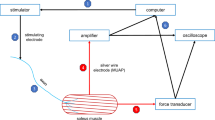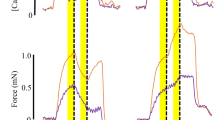Abstract
The operation of cross innervation of mammalian skeletal muscles has been described before1,2 together with the observation that as a result of this procedure the normally fast twitch skeletal muscles contract more slowly and the usually slow twitch muscles contract more rapidly. Although, as a result of cross innervation, fast twitch muscles slow to an extent which renders their isometric twitch contractions indistinguishable from those of normal or self reinnervated slow twitch muscles, the contraction characteristics of cat cross innervated slow muscles have never been observed to become as rapid as in normal or self reinnervated fast twitch muscles. In addition, while the values of the tetanus twitch ratios of cross innervated fast muscles fall within the range found in normal mammalian muscles, the tetanus twitch ratio values of cross innervated slow twitch muscles are almost invariably high1,2. The cats on which these previous observations were made had been left for periods averaging approximately 1 yr between the aseptic operation and the final observations. It seemed possible that after a longer interval there might be a more complete transition of the slow twitch muscle. We have therefore studied three cats on which the cross innervation operations had been performed between 4 and 5 yr earlier. In two cats cross innervation of soleus (a slow twitch muscle) and flexor hallucis longus (FHL, a fast twitch muscle) had been performed, while in the third cat flexor digotorum longus (FDL) was used instead of FHL. The transition of all three fast muscles was complete; their times to peak tension had lengthened approximately three-fold to values found for normal soleus muscles. Their tetanus twitch ratios were also normal, averaging 4.6 (range in normal muscles, 4.0–6.9, mean 5.4). Even after 4 yr, however, the cross innervated slow twitch muscles were unambiguously different from normal fast muscles (Fig. 1). The times to peak tension had only fallen to approximately half the values found in the control muscles, and the tetanus twitch ratios were still high, averaging 7.0 (range in normal muscles, 3.6–5.7, mean 4.5). It therefore seems likely that in the cat the cross innervation of normally slow twitch mammalian muscle cannot produce a muscle with characteristics similar to normal fast muscle. It is, however, interesting that the characteristics produced are very similar to those observed in the soleus muscles of kittens within a week of birth3,4.
This is a preview of subscription content, access via your institution
Access options
Subscribe to this journal
Receive 51 print issues and online access
$199.00 per year
only $3.90 per issue
Buy this article
- Purchase on Springer Link
- Instant access to full article PDF
Prices may be subject to local taxes which are calculated during checkout
Similar content being viewed by others
References
Buller, A. J., Eccles, J. C., and Eccles, R. M., J. Physiol., 150, 417 (1960).
Buller, A. J., and Lewis, D. M., J. Physiol., 178, 343 (1965).
Buller, A. J., and Lewis, D. M., J. Physiol., 176, 355 (1965).
Close, R., and Hoh, J. F. Y., J. Physiol., 192, 815 (1967).
Buller, A. J., Ranatunga, K. W., and Smith, J., J. Physiol., 196, 82 (1968).
Author information
Authors and Affiliations
Rights and permissions
About this article
Cite this article
BULLER, A., RANATUNGA, K. & SMITH, J. Influence of Temperature on the Isometric Myograms of Cross Innervated Mammalian Fast Twitch and Slow Twitch Skeletal Muscles. Nature 218, 877–878 (1968). https://doi.org/10.1038/218877a0
Received:
Published:
Issue Date:
DOI: https://doi.org/10.1038/218877a0
This article is cited by
-
Transformation of contraction speed in muscle following cross-reinnervation; dependence on muscle size
Journal of Muscle Research and Cell Motility (1987)
-
Increased voltage of the muscle action potential of normal subjects after local cooling
Journal of Neurology (1977)
Comments
By submitting a comment you agree to abide by our Terms and Community Guidelines. If you find something abusive or that does not comply with our terms or guidelines please flag it as inappropriate.



